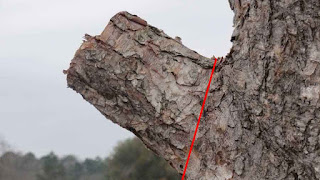A Do-It-Yourself Guide
 |
Heavy snow storms can cause a lot of damage to trees and shrubs. They
usually recover quite naturally, but sometimes need some help.
Here are some helpful first aid tips for trees.
Broken limbs and
branches may be repaired by setting them as a doctor would a broken
bone. If the breaks are fairly clean and fresh, the broken ends may
be put back in place, tightly bound, properly supported, and allowed
to grow together. Here’s how:
- Begin the repair immediately. If the damaged tissue has dried after several days or even hours of separation, it’s unlikely to repair itself.
- Line up the broken ends, giving special attention to all of the outer edges for they contain the cambium tissue. Cambium is responsible for repairing and replacing damaged cells, and forming bark. If the edges don’t meet, they won’t grow together properly.
- Wrap the mend tightly with grafting tape.
- Spread or spray tree wound dressing on the repaired area to form a moisture barrier. (Whether this is actually necessary is a subject of debate within the horticultural community.)
- Support the break with wooden splints along the sides, above and below, tightly wrapped. 1” x 2”grade stakes or tree stakes of sufficient length are good for larger branches. Longer limbs and branches might need to be propped up from the ground with 2” x 4” timbers. Stakes and timbers can be purchased at a local hardware store. Grafting tape can be purchased online or from a garden center.
- Leave everything in place for at least one growing season, and possibly two. But inspect the mend every few weeks to make sure that it isn’t restricting (i.e. choking) the branch as it thickens.
After all that, the
grafting might not be successful, especially if the break was ragged
or dirty. Limbs seldom break evenly.
Jagged edges present real
problems, for it’s difficult to match the broken ends for a strong
repair. If so, remove the limb behind the break, if possible. New sprouts may form
to replace the broken limb. (Not all species are accommodating.)
Aesthetically, this works best on younger branches. Older limbs might
not sprout at all, and if they do, they might look like crap. If
that’s the case, you might be better off removing the limb
entirely. Here’s how:
- Identify the “collar” where the limb joins the trunk. It’s a swollen area that surrounds the base of the limb at the trunk. This structure contains all the regenerative tissue needed to heal over the cut.
- Cut the limb cleanly and evenly at the outer edge of the collar.
- Trim off any ragged edges.
- Trim off the stub, if you cut too far out. If a stub is left poking out, the tissue can’t grow over the wound. The stub will die, and the necrosis (death) will proceed into the trunk itself, weakening the whole plant, and eventually causing its death. If the collar is removed, the wound will take longer to heal, if it heals at all.
- Apply wound dressing if it makes you feel better.
 |
| Proper place to cut tree limb stub |
If new sprouts emerge from the cut area, one might be chosen to replace the missing branch. Here’s how:
- Remove the weakest sprouts when they are fresh and recently emerged. (This might require doing more than once.) Rub or pinch them off with your fingers.
- Use a small weight or weights to train the chosen sprout into the proper position as it grows.
- Better still, use a limb spacer or spreader to achieve the proper angle. You can make them yourself from thin strips of plastic or wood lath, cut to the desired length, and notched at both ends to hold them in place.
If a load of snow
has bent the tree or shrub – this is usually the case with upright
evergreen junipers and arborvitae – it is more easily repaired.
Remove the snow, wrap some rope or soft twine around the plant, and
tie it upright. If snow or ice cannot be removed without doing damage
to the branches, leave it alone, pray that no more snow falls, then
wrap the plant after snowmelt.
Return to GoGardenNow.com.



No comments:
Post a Comment